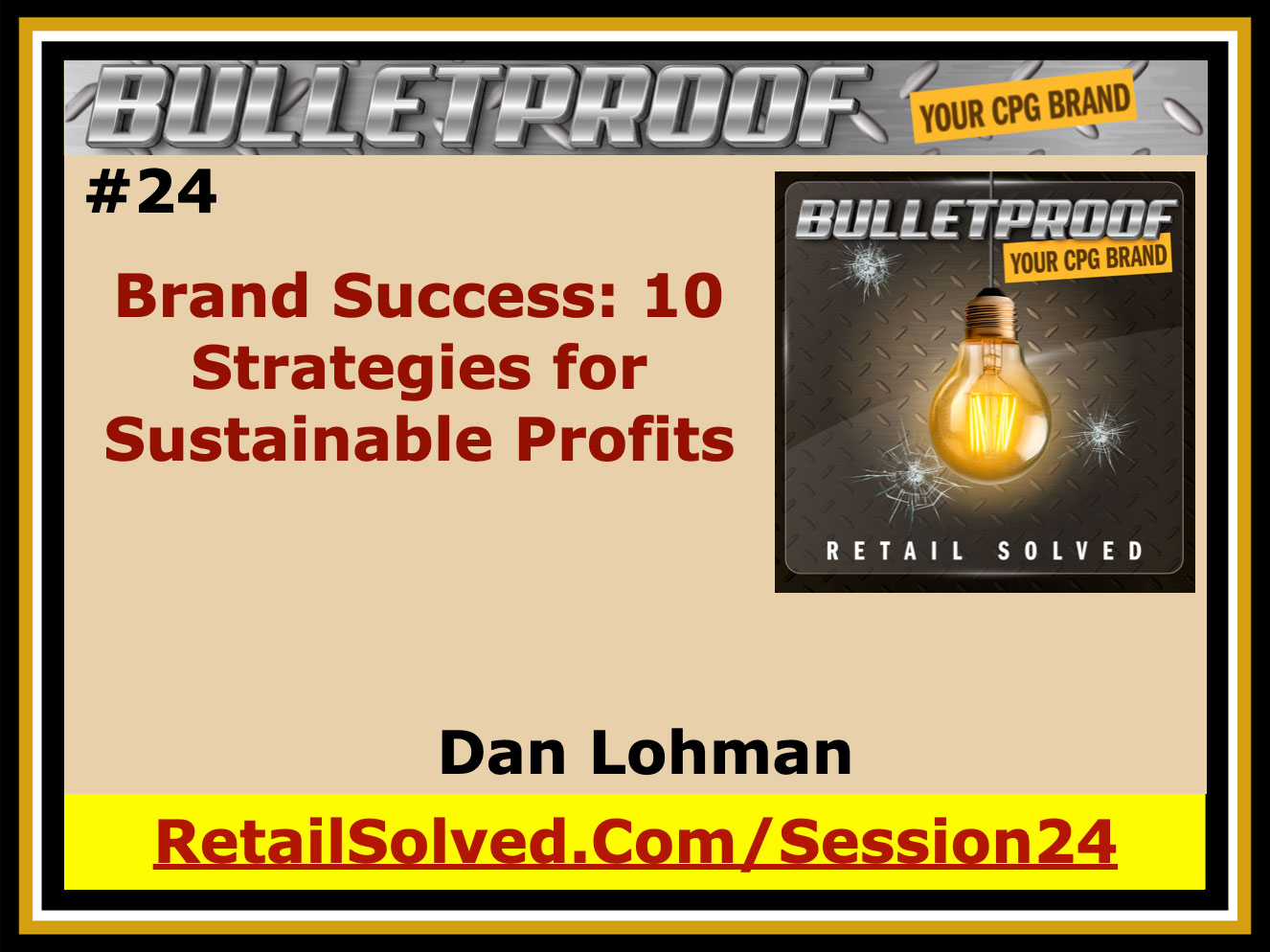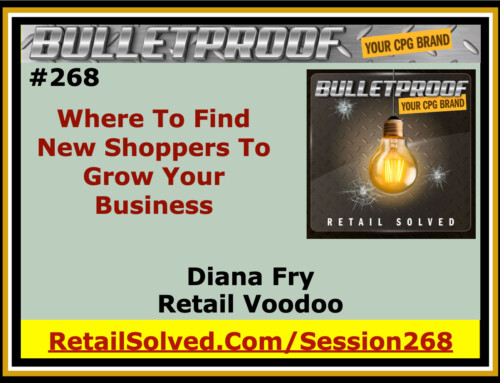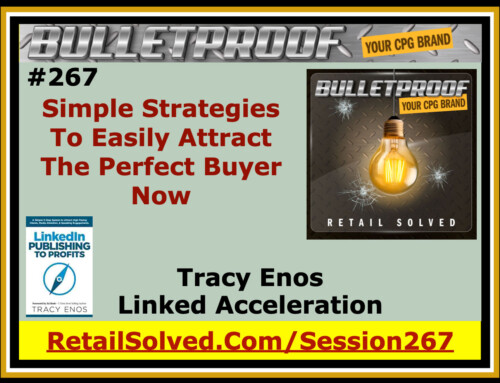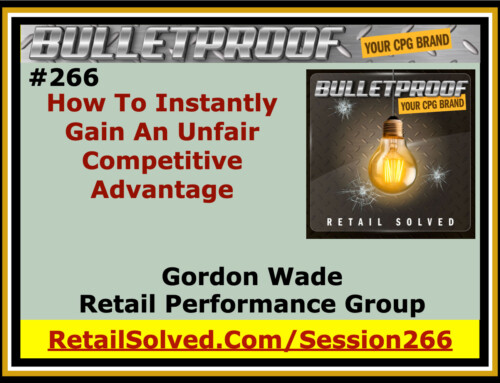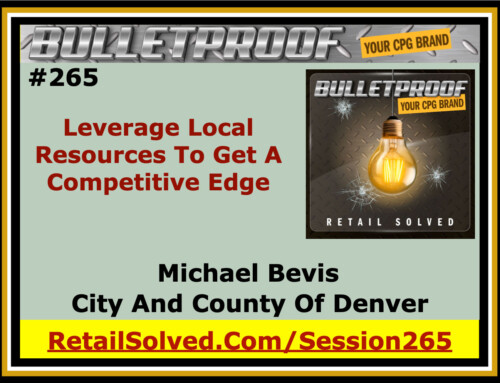Unlock brand success with proven strategies that set you apart as a leader in your industry. Achieve sustainable growth today. Learn ten strategies for building sustainable sales and profits beginning with emphasizing the importance of understanding retailers shoppers, becoming their trusted resource, and leveraging actionable insights to develop loyalty programs and promotions.
Every brand's success can be traced back to how well they execute fundamental strategies. Small nuances in the way brands plan, implement, & collaborate with retailers can set you apart as the category leader giving you a sustainable competitive advantage.
Listen where you get your podcast
Important: Brand Secrets and Strategies has been rebranded to Retail Solved. Please swap all BrandSecretsandStrategies.com URL’s with RetailSolved.com. This is now the Bulletproof Your Brand podcast. Thank you for listening! BRAND SECRETS AND STRATEGIES PODCAST #24 Hello and thank you for joining us today. This is the Brand Secrets and Strategies Podcast #24 Welcome to the Brand Secrets and Strategies podcast where the focus is on empowering brands and raising the bar. I’m your host Dan Lohman. This weekly show is dedicated to getting your brand on the shelf and keeping it there. Get ready to learn actionable insights and strategic solutions to grow your brand and save you valuable time and money. LETS ROLL UP OUR SLEEVES AND GET STARTED! Welcome. Today I want to talk to you about a problem that plagues all businesses. I work brands at all levels of development, from pre-revenue startups, to multi billion dollar companies with a strong global presence. They all have these similar problems in common. Today I want to share with you 10 strategies to help you build sustainable sales and profits. As you begin to develop your business strategy for the next year, it's wise to first reflect on the prior year. Did you achieve all your business objectives? Did you reach your goals? What would you have done differently, given the opportunity? Did your actual results match the goals of the projections that you set? These are all important questions you need to answer. What I find is that when brands are setting their New Year's resolutions, typically they don't complete the project. Or, they put it off. Now is the time for you to take this seriously. And again, like I said, it's not just the small brands that struggle with this. It's even the large brands. I'll explain more in a minute. This is the first place to start when developing your business strategy. Next look at the goals themselves. Were your previous goals reasonable and achievable? Don't set goals that are out of reach. For example, if grew 5% last year, don't set a goal of 25% for the next year. Your goals should be smart goals. They should be Specific. Measurable, Attainable, Realistic, and Timely. Resolutions are similar to goals. They encourage and motivate us to achieve more than we did previously. While you should set your business goals at least 6 to 12 months ahead on the calendar in order to achieve them, I find that most of the businesses that I work with don't have really well defined goals. And what I mean by that is that, you want to make more money, but exactly what kind of money do you want to make next month? 5% more, 10% more, as I suggested. Well, if you break that down, where are those revenues going to come from? Who's going to be responsible? And what makes you think that they're achievable? What math or what science do you have, if you will, behind that goal to know that this is an attainable goal? If you're not focusing on these 12 different areas, I guarantee you're not going to reach your goal, or are not going to be as successful as you could be otherwise. Number one. Know your retailers you serve. Now I'm not talking about knowing where their headquarters office is, and who the buyer is. I'm talking about really getting to know your retailer. You might call this retailer account penetration. Here's why it's important. You need to know who shops at that store, what they look at, what they buy when they shop at that store, why their consumers shop them versus their competition, or the other way around. And then you also need to understand what their mission is. What are the store's tactics and strategies for given categories. And we'll get into that later episodes. You need to know not only who your buyer is, but the entire support staff. Who's the person you need to go to if you have a logistics problem, if you have a stocking problem, you have a signage problem? You need to know each and every one of those people. And don't just know their names. Get to know them. Get to know something about them, so that you can have a relationship with them, same as you would have a friend. This is going to put you in a position where they'll be able to help you get what you need, because you're going to be focused on helping them get what they need. This is one of the big differentials that I'm talking about throughout this entire series. A lot of brands go to the retailer and say, "Here's what I want. Here's what I need." And they get out their checkbook and so on and so forth. If you can become a value added resource to the retailer, and provide them what they need, and by the way, retailer's just need two things. They need more shoppers, and they need those shoppers to spend more at their store. If you can help the retailer attain those two objectives, they're going to bend over backwards to help support you, because they realize that your goals within that retailer are in perfect alignment. I've built my entire career by focusing on this single attribute. And what it's done for me is, it's given me opportunities to get incremental merchandising. To get preferential opportunities to promote. They called me first when they had an end cap that was open, or maybe a deal fell through with another vendor and they needed someone to fill that gap. They reached out to me when they needed advice on the category, perhaps even a different category, to understand not only who shops a category, but perhaps how they should merchandise it. The point being is this, if you can help the retailer accomplish their goals, be laser focused on that, that retailer is going to view you as value added resource. And that retailer is going to bend over backwards to help support you, as well. And that leads me to number two. Become a trusted value added resource for all your retail partners. Become a category leader. Now this doesn't mean be the actual category captain. There's a difference here. A category captain is someone who works with the retailer to help drive strategy within that category. If you're a category leader, you can do that and not have the responsibility of a category captain, but be able to demonstrate how you can help drive sales and profits within that category. Apply your passion to develop the best strategies, and grow the category retail. Your sales will increase as the category grows, and the retailer will reward you the support that you give them. Retailers already know how your brand's doing. They don't need you to show up and say, "Look, here's a ranking report. We're ranked number two and our sales are up 3%." They want insights. They want actionable insights that they can leverage to help drive sales in the category and compete in their market. They, again, want to know who buys the product. When someone buys your product, what else do they buy? How do they shop the category? What does their market basket look like? And how your consumers shop their store, versus their competition. Know your customers and your competitors customers intimately. Let me break this down. A lot of brands really don't know who shops their brand, the customers that shop their products. You need to know and understand what that customer looks like, why they shop their product, what they like, what they don't like. From your customer's perspective, why do they choose you over the other guy? Next, you need to know your competitor's customers intimately. Why do they shop the competition? What do those customers look like? What is the value proposition that those customers are shopping for when they choose your competition over you? The more you know about your competitor, the better you're able to address the needs of your shoppers, and help the retailer better meet your shoppers needs, or if you will, better leverage your brand to drive sales in their category. This information is invaluable. You can use this to help develop a loyalty program that differentiates your brand, and attracts new customers. Some of the most successful programs that I've seen are programs that extend beyond the four corners of the package, where you're able to bring the customer to your website to educate them not only about the product, but how to use the product. A new recipe. Who else is using it? Different and creative ways to think about the product and to be able to use it in some of their every day solutions. Number four. As I mentioned, know your competition. Become an expert on all things your competition. The better you know them, the better you'll be able to compete. Now I've already mentioned that you need to know who their customer is. But you also need to know what are their strategies, who do they merchandise their product, when do they promote their product, how deep do they discount, what are their preferential strategies? If you know how your customer competes, how they promote, et cetera, then you can develop strategies around them, so that you are not trying to compete with them at the same time during a promotion. I'll give you an example. One of the largest CPG companies in the world has a strategy where they promote all of their brands about the same time of the year, every year. Well, most of the other brands that are smart, they stay away from that. They let the brand do their own thing. But, in the off-season from them, if you will, they offer deep discounts. They focus on driving promotions through end caps and other displays and other vehicles. The point is, it's a lot less expensive to compete against someone, when you're not trying to play the pricing game. Everyone loses when you play the price game. Using this strategy is going to help you stand out from the rest. It's going to help you help the retailer drive sales in the category and beyond. I mentioned that you need to know your competitor's strategies. That's number five. Adopt strategies that make sense and improve on them. Make them your own. Understand the strategies used by leading brands and other categories. This is the shortest path to your growth. In other words, if a product in an entirely different aisle has a strategy that really drives a lot of sales for them, it might be something you might be able to replicate. Or, perhaps you can find a complementary product that you can align your product with. Co-merchandising any product is a great solution. Co-promoting with another complementary product is a great way to build sales. Number six. Know your competitors promotional strategies. Now I'm getting a little bit deeper into the promotional strategy. Not just when they're doing it, but now, know the depth and the frequency of which your competitor competition promotes their products. Their strategies may be different in each channel. You need to know that. Develop a strategy that will grow profitable sales that attract their customers. Remember, the goal is to be able to convert their shoppers into your shoppers. A lot of brands simple use the strategy of rinse and repeat. In other words, they simply repeat what they did last year. Maybe change it up a little bit, but for the most part, it's the same tactic. If you can learn their strategy, and then be able to use that to your advantage, where you're able to come up with something that's creative, something that fits into the gap of when they're not promoting, for example, and perhaps, find a way to leverage that strategy to grow sales in the category. And remember, other categories that are complementary. What I mean by this is that, if you're an organic butter, it'd be a great strategy to learn when the bread companies promote their products. That way, you could compliment their promotion without actually being directly tied to them. So that, a customer comes in and buys your organic butter, and then maybe goes out and buys the organic bread. Or perhaps you're a pasta sauce, and you know when the companies that produce the noodles promote their product. Again, learn the competition. Learn what's going on in other categories. Understand what the complimentary products are doing, and try to develop a strategy to work around them. This is how you stand out on a crowded shelf. Remember, a lot of the brands that are promoting are simply, again, rinse and repeat. This is what we did last year. This is what we're going to do next year. Number seven. Commit to a loyalty strategy. Don't talk at your loyal shoppers, speak to them directly. Engage your customers and get them talking about your product. Keep the conversation going, is the easiest way to develop a loyal following. Social media sites like Twitter and Facebook, et cetera, can accomplish this as much if not more than some targeted retailer programs. By the way, on that note, loyalty programs, kind of a myth in my mind. Here's why. I have a loyalty card for every retailer within my market. I also have a loyalty card for every airline. My point is this. Most customers view a loyalty card as a coupon. The disconnect is that the retailer thinks that a loyalty card is what keeps that customer coming back. The disconnect for the retailer is that loyalty cards don't generate loyalty. Loyalty comes from providing the best service, the best product, the best assortment, the best mix of price and everything else that the customer's looking for. Loyalty comes from exceeding the customer's needs. True loyalty is when your customer can evangelize you, the retailer, or your product to their friends and family. This goes way beyond the loyalty card. So back to the earlier points I made. Your opportunity here is to help the retailer understand how you can drive your loyal shoppers into their store. And if you can drive your loyal shoppers into their store, that's worth far more than paying slotting fees, or paying some of menu fees. That's worth far more than anything that your competition is doing. This, again, is how you stand out. This, again, is how you become a category leader. This, again, is how you get your products into the hands of more customers. Number eight. Lower your cost of goods sold. Now you notice here, I did not say lower your price. You hear all the experts, the quote unquote experts saying you need to lower your price. Price is the only drive in the category. It's the only thing that motivates customers to buy products. That's not true. And here's why. Indulgent products and luxury products are continually growing in popularity. Customers are going to pay for what they want. The customers that shop for them, buy natural organic brands, are paying for the promise of quality. They want what they want, and they're willing to pay a premium for it. Those are your customers. Those are the customers that the retailer wants to attract to their store. Help the retailer understand how your customer is not so price sensitive. More importantly, how your customer, again, when they come into the store, their focus is going to be on finding the items that best meet the needs of themselves and their families. Your customer is going pay more attention to the products that are going to sustain their family. So back to this point. Develop strategies to improve and optimize your internal efficiencies. There are two ways to improve profits. Increased sales and reduced costs. Some businesses are so focused on the former that they overlook the latter. Both are equally important. Ways to improve sales could be as simple as closing any of the distribution gaps. Maybe getting your product merchandised where it's easier to find. Making sure that you reduce and eliminate out of stocks. Making sure that when you promote your product, you've got more than enough product in the back room to be able to support any promotion. Sounds pretty simple, but believe me, even the big brands struggle here. As far as reducing costs, the easiest way to do that is to help get the product on the shelf more efficiently. This includes making the logistics more efficient. This includes removing or reducing or eliminating deductions that are inefficient. Reducing the amount of paperwork or additional paperwork that some brands and retailers generate, because of these lack of efficiencies. Another key way to do this is to plan everything well in advance, so that you have the right products available to support every sale. Again, this is why we're having this conversation today. Effective trade spinning typically provides the greatest opportunity to reduce wasteful spending, and maximize sustainable sales. Commit to maximizing your trade management ROI. We'll talk more about this in later episodes. But the point here is this, make sure that when you're spending money to promote your product, that you're getting your biggest bang for your buck, and that you're doing your best to provide the greatest return to the retailer. Number nine. Commit to working smarter not harder. Develop an organizational strategy that keeps you on track, and laser focused on your goals. Have a system to validate your results and measure your progress at regular intervals. A score card is a great tool to help you work smarter and accomplish more. We've talked about this a lot. A score card is a great tool to use for project management, or something as simple as making sure that someone ordered the right product for their promotion at the right time. To make sure that you avoid out of stocks, et cetera. I created an example of a score card. If you want it right away, you can text “retailscorecard” to 44222. Or you can find it on my website. Number ten. Be excellent in everything you do. Don't allow yourself to make excuses. Don't blame the distribution company because your product shows up late. Make sure that you have every aspect of your sales funnel covered. Make sure that you've got everything in place to support your sales, to put your best foot forward. If your name's on the store, or your name's on the package, then the success or the failure of anything you do is going to be tied to you, and or your brand. That's a harsh reality, but it's something I think most brands need to work on. The point being here is that, if you want to make sales, you have an opportunity to get the product on the shelf. And if you can't keep that shelf full, then who suffers the result? Who pays the consequence? You do. And the reason you do is because customers can't buy what they can't find. Commit to being the very best at what you do, and sales will follow. Excellence is contagious. Challenge your entire sales team to grow and excel every day. Make sure that your actions reflect what you say. Let the retailer know. Show the retailer by your actions, not just by your words, that you're there to commit to their support, to their growth, to their excellence, as well. Your commitment to these simple strategies will give you sustainable competitive advantage in 2018 and beyond. The freebie this week is my 10 strategies. You can text “10strategies” to 44222, or you can get it on the website on the show notes. The show notes can be found at brandsecretsandstrategies.com/session24. Thanks again for listening. I've got big plans for the rest of the year. Like I say, this show is about you, and it's for you. I plan to deliver even greater value. And as always, I'd love to hear your comments. I appreciate your feedback. If there's something you'd like me to cover, a topic or anything, please send me an email and let me know. I'm always open to new ideas. And I'll be sharing a lot of those with you in the next couple weeks. Thanks again for listening, and I'll look forward to seeing you in the next show. This episode's FREE downloadable guide Scorecards are powerful goal setting tools. You’ve probably heard that “what gets measured gets done”. Scorecards map out objectives in bite-size manageable chunks that keep you on-track and focused. They're what you need to succeed. CLICK HERE TO DOWNLOAD YOUR FREE STRATEGIC GUIDE: Retail Scorecard Thanks again for joining us today. Make sure to stop over at brandsecretsandstrategies.com for the show notes along with more great brand building articles and resources. Please subscribe to the podcast, leave a review, and recommend it to your friends and colleagues. Sign up today on my website so you don’t miss out on actionable insights and strategic solutions to grow your brand and save you valuable time and money. I appreciate all the positive feedback. Keep your suggestions coming. Until next time, this is Dan Lohman with Brand Secrets and Strategies where the focus is on empowering brands and raising the bar.
Enter your name and email address below and I'll send you periodic brand building advice, tips and strategies.
Sign up to receive email updates
FREE Trade Promotion ROI Calculator:
Click Here To Maximize Sales And Profits
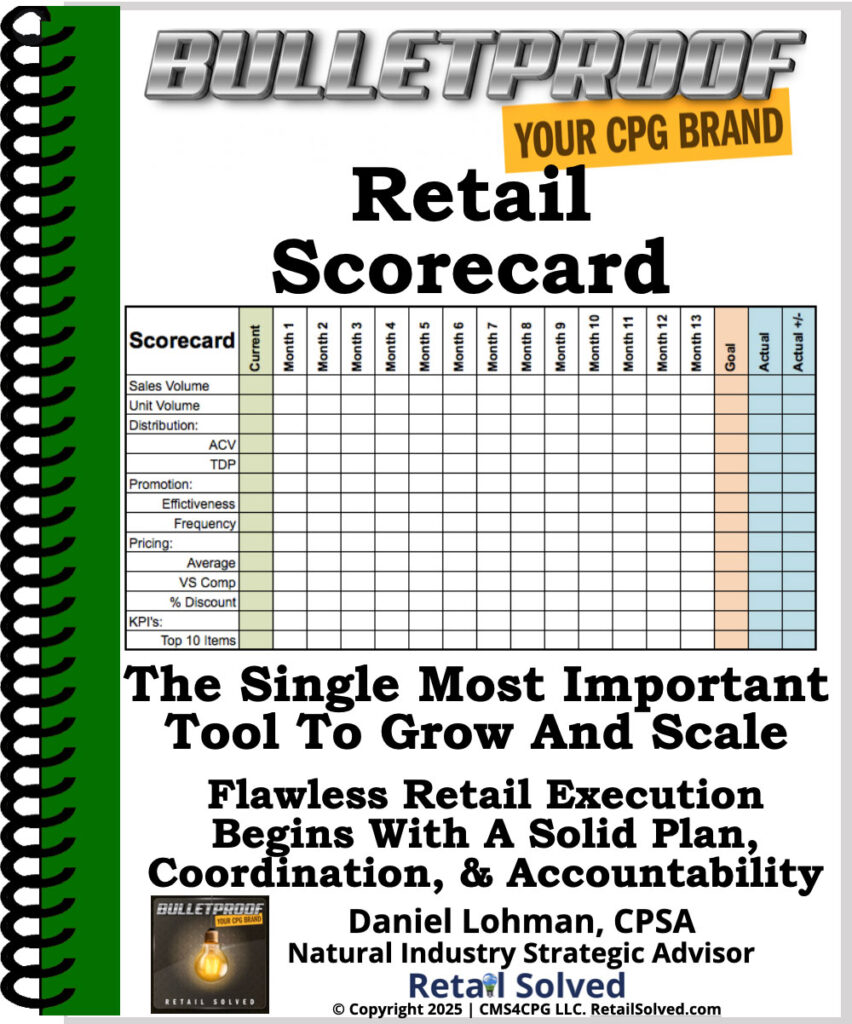
Retail Scorecard – Maximize Retail Execution
Want The Most Effective Tool To Maximize Retail Execution?
Exploit your competitions weaknesses by committing to this simple strategy that they overlook. Scorecards are the most powerful and underutilized project management and goal-setting tools that help brands achieve success by breaking down objectives into manageable chunks. Learn how to unlock their awesome power to gain a significant unfair competitive advantage. They’re what you need to succeed!
Image is the property of CMS4CPG LLC, distribution or reproduction is expressively prohibited.
